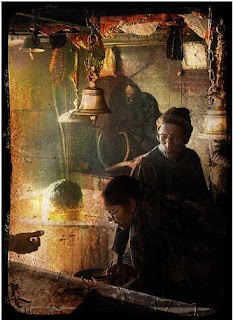Lord Shiva, grants wishes and specially those that are made from the bottom of one’s heart. As we waited, sweating it out within the innermost prakara, the stillness in the air and the rising smoke create an unforgettable aura.
When the curtains are down, the devotees wait in chattering queues wanting to get a glimpse of the Lord while he still hides behind the curtain, as the priest performs alankaram. And once the curtains are pulled, there is stunned silence for the million lamps that light the inside, describe the beauty and energy of this shrine in a sacred glamour to be found nowhere else.
As one gasps again for breath, this beauty making every one forget their miseries is a moment no one can steal away from any bhakta, its precious, its profound and its sacred bringing such sense of peace that all the chattering is drowned into divine silence. The prayers roll on, and the arti lamps rise, one after the other as the lord is illumined with every lamp brought forward.
Divinity and sacred energy washes every devotee as they take a glimpse of the shrine of Lord Shiva within, and walk out only to turn back occasionally to catch a second glance as they proceed in silence to take their pradakshina. As one walks through the corridor, looking up at Nataraja as he dances within his chamber, his omnipresence envelopes the entire passage. The lights suddenly go out, and the passage is plunged into darkness.
It’s a darkness that transforms the temple back in to the past, to the medieval period, where only the divine lamps glow near the deities within the niches. It’s a different world, as one crosses Dakshinamurthy.
taM ha devamaatmabuddhiprakaashaM
mumukshurvai sharaNamahaM prapadye ||
AUM shaa.ntiH shaa.ntiH shaa.ntiH||
I surrender to Him who projects Brahma at the beginning of all creation and reveals the sacred syllables of the Vedas. This inspiration turns my intellect and my thought towards Atman. May He bestow peace on us forever.
He sits there in silence, the Vedas flowing forth from him, a realm that comes alive, so true and so pure and so far away from the reality we know. Silence grips the air, with the shimmering light of the flickering lamps on his face, as he blesses in abhaya, seated with his divine feet on apasmara. One could stand there forever and wish for the lights never to come back. Walking around this passage, with each emblem of divinity glowing in lamp light brings such beauty to this interior; one begins to wonder, did we make a mistake by putting these electric lamps around here? As our minds seep into this reality, short lived yet worth every moment, one can see the divinity of Lord Dakshinamurthy come alive. In the still air the expression of wisdom and divine light glow on His face as he continues to teach in the subtle world:
GYaanaM yasya tu chakshuraadikaraNadvaaraa bahiH spandate |
jaanaamiiti tameva bhaantamanubhaatyetatsamastaM jagat.
tasmai shriigurumuurtaye nama idaM shriidakshiNaamuurtaye ||
He whose light gleams through the senses like the light emanating from a pot with holes (in which a lamp is kept), He whose knowledge alone brings the state of knowing (I am That), He whose brightness makes everything shine - to that Dakshinamurti, who is embodied in the auspicious Guru, I offer my profound salutations.
Temple authorities need to bring back that ancient glory that ancient divinity prescribed in our Vedas, divine verses that prescribe that temples are meant for realization of this sacred truth… Why then is this desecration to a sacred shrine accepted as a part of life?
Why then are the priests who are the seekers of enlightenment, reducing themselves to mechanical worshippers? Why then are the priests who are learned and the keepers of our faith disrespecting the very value of our sacred texts? How then can we blame anyone else for the loss of knowledge of our own culture? Are they not solely to blame? Why don’t they realize that they owe us, the answers to these very very serious questions They owe us an answer as to why corruption and materialism has taken over their minds when this country boasts of its spiritualism. What really is left of it?
sanmaatraH karaNopasa.nharaNato yo.abhuutsushhuptaH pumaan|
praagasvaapsamiti prabodhasamaye yaH pratyabhiGYaayate
tasmai shriigurumuurtaye nama idaM shriidakshiNaamuurtaye ||
The brillance of sun exists even when intercepted by Rahu during eclipse. Similarly, the power of cognition only remains suspended during deep sleep. The Self exists as pure being even though unrecognized due to the veil of Maya. A person on awakening becomes aware that he was asleep earlier (and the dream was unreal). Similarly, a person who awakens to the consciousness of the Self recognizes his previous state of ignorance as unreal. He by whose grace alone does one awaken to the consciousness of the Self - to that Dakshinamurti, who is embodied in the auspicious Guru, I offer my profound salutations.





















